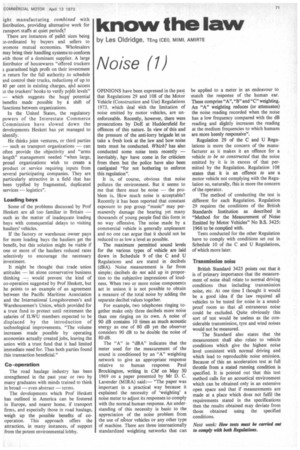know the law
Page 73

If you've noticed an error in this article please click here to report it so we can fix it.
by Les Oldridge, TEng (CEO. MIMI, AMIRTE
Noise (1)
OPINIONS have been expressed in the past that Regulations 29 and 108 of the Motor Vehicle (Construction and Use) Regulations 1973, which deal With the limitation of noise emitted by motor vehicles, are unenforceable. Recently, however, there were prosecutions by DoE at Huddersfield for offences of this nature. In view of this and the pressure of the anti-lorry brigade let us take a fresh look at the law and how noise tests must be conducted. Which? has also conducted some noise tests recently — inevitably, hgv have come in for criticism from them but the police have also been castigated "for not bothering to enforce this regulation".
It is, of course, obvious that noise pollutes the environment. But it seems to me that there must be noise — the problem is, How much noise is acceptable? Recently it has been reported that constant exposure to pop group "music" may permanently damage the hearing yet many thousands of young people find this form in no way offensive. The noise made by a commercial vehicle is generally unpleasant and no one can argue that it should not be reduced to as low a level as possible.
The maximum permitted sound levels for the various types of vehicle are laid down in Schedule 9 of the C and U Regulations and are stated in decibels (dBA). Noise measurement is far from simple; decibels do not add up in proportion to the subjective impressions of loudness. When two or more noise components act in unison it is not possible to obtain a measure of the total noise by adding the separate decibel values together.
For example, two telephones ringing together make only three decibels more noise than one ringing on its own. A noise of 90 dB contains 10 times as much acoustic energy as one of 80 dB yet the observer considers 90 dB to be double the noise of 80 dB.
The "A" in "dBA" indicates that the meter used for the measurement of the sound is conditioned by an "A" weighting network to give an appropriate response relative to human response. Paul Brockington, writing in CM on May 30 1969 on a paper presented by Mr D. C. Lavender (MIRA) said:— "The paper was important in a practical way because it explained the necessity of 'weighting' a noise meter to adjust its responses to comply with the normal human response. An understanding of this necessity is basic to the appreciation of the noise problem from the use of Motor vehicles or any other type of machine. There are three internationally standardized weighting networks that can
be applied to a meter in an endeavour to match the response of the human ear. These comprise "A", "B" and "C" weighting. An "A" weighting reduces (or attenuates) the noise reading recorded when the noise has a low frequency compared with the dB reading and slightly increases the reading at the medium frequencies to which humans are more keenly responsive".
Regulation 29 of the C and U Regulations is more the concern of the manufacturer as it makes it an offence for a vehicle to be so constructed that the noise emitted by it is in excess of that permitted by the Regulation. Regulation 108 states that it is an offence to use a motor vehicle not complying with the Regulation so, naturally, this is more the concern of the operator.
The method of conducting the test is different for each Regulation. Regulation 29 requires the conditions of the British Standards Institution as described in "Method for the Measurement of Noise Emitted by Motor Vehicles" No B.S. 3425: 1966 to be complied with.
Tests conducted for the other Regulation have to comply with conditions set out in Schedule 10 of the C and U Regulations, of which more later.
Transmission noise
British Standard 3425 points out that it is of primary importance that the measurement of noise shall relate to normal driving conditions thus including transmission noise, etc. At one time I thought it would be a good idea if the law required all vehicles to be tested for noise in a soundproof room so that all extraneous noise could be excluded. Quite obviously this sort of test would be useless as the considerable transmission, tyre and wind noises would not be measured.
The Standard also states that the measurement shall also relate to vehicle conditions which give the highest noise level consistent with normal driving and which lead to reproducible noise emission. Because of this an acceleration test at full throttle from a stated running condition is specified. It is pointed out •that this test method calls for an acoustical environment which can be obtained only in an extensive open space and that if measurements are made at a place which does not fulfil the requirements stated in the specifications then the results obtained may deviate from those obtained using the specified conditions.
Nest week: How tests mast be carried out to comply with both Regulations.
























































































































